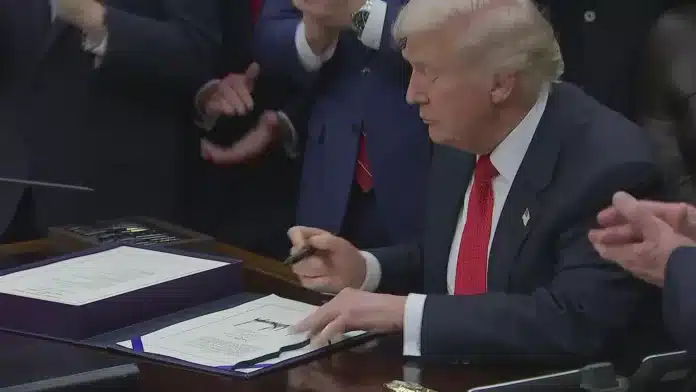International Desk – U.S. President Donald Trump signed a government funding bill on Wednesday night (November 12, 2025), officially ending the longest shutdown in American history a 43-day halt that left federal workers unpaid, caused chaos at airports, and forced many people to line up at food banks.
The shutdown highlighted deep political differences in Washington. During the standoff, Mr. Trump took several unusual actions including cancelling projects and attempting to fire federal employees to pressure Democrats during negotiations.
Trump Blames Democrats
After signing the bill, President Trump blamed Democrats for the shutdown and urged Americans to remember this during next year’s midterm elections.
“Don’t forget what they’ve done to our country,” he said.
The House passed the funding bill earlier in the day with a narrow 222–209 vote, mostly along party lines. The Senate had approved it on Monday.
Why the Shutdown Happened
Democrats insisted that the funding bill must include an extension of a health insurance tax credit, which helps lower the cost of health coverage under the Affordable Care Act.
Republicans said that issue should be handled separately not as part of a temporary spending bill.
Republican Rep. Tom Cole said shutdowns never work:
“You haven’t achieved your objective, and you’re not going to.”
Sharp Exchanges in Congress
Debate in the House reflected the frustration caused by the shutdown.
Republicans accused Democrats of using the shutdown to gain advantage in a policy fight.
Democrats argued that Republicans had earlier passed tax cuts that favored the wealthy and were now refusing to help families struggling with health care costs.
Democratic leader Hakeem Jeffries vowed to keep fighting for the subsidy:
“This fight is not over. We’re just getting started.”
How the Deal Was Reached
The shutdown dragged on so long that a group of eight senators broke ranks and negotiated a compromise.
The final bill:
Funds three major annual government budgets
Extends funding for the rest of the government until January 30
Promises a vote in mid-December on extending the health care subsidies (although the outcome is uncertain)
Protections for Federal Workers
The bill:
Reinstates federal workers fired by the Trump administration during the shutdown
Prevents more layoffs until January
Guarantees all workers will receive their unpaid salaries
Funding for the Agriculture Department means food assistance programs will continue without disruption for the rest of the budget year.
Other Measures in the Bill
$203.5 million to improve security for lawmakers
$28 million for Supreme Court security
A controversial clause allowing senators to sue federal agencies for unauthorized searches of their electronic records a move criticized by both parties.
iggest Fight Still Ahead: Health Care Subsidies
The main issue that triggered the shutdown the expiring health insurance tax credit remains unresolved.
Without the subsidy:
Premiums could double for millions
Over 2 million people may lose their health insurance, according to the Congressional Budget Office
Republicans say the subsidies were meant only for the COVID period, but some are open to extending them with new income limits.
Democrats doubt Republicans will support any meaningful extension.

